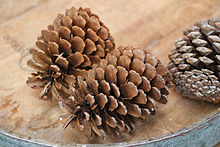- Maritime Pine
-
Maritime Pine
Pinus pinaster

Conservation status Scientific classification Kingdom: Plantae Division: Pinophyta Class: Pinopsida Order: Pinales Family: Pinaceae Genus: Pinus Subgenus: Pinus Species: P. pinaster Binomial name Pinus pinaster
AitonPinus pinaster, the Maritime Pine, is a pine native to the western and southwestern Mediterranean region. The pejorative name 'pinaster' is derived from pinus + aster, translating as 'a poor imitation of a pine' (cf. poetaster).
Contents
Distribution
The range extends from Portugal and Spain north to southern and western France, east to western Italy, and south to northern Morocco, with small outlying populations in Algeria and Malta (possibly introduced by man). It generally occurs at low to moderate altitudes, mostly from sea level to 600 m, but up to 2000 m in the south of its range in Morocco.
Description
Pinus pinaster is a medium-size tree, reaching 20–35 m tall and with a trunk diameter of up to 1.2 m, exceptionally 1.8 m.
The bark is orange-red, thick and deeply fissured at the base of the trunk, somewhat thinner in the upper crown.
The leaves ('needles') are in pairs, very stout (2 mm broad), 12–22 cm long, and bluish-green to distinctly yellowish-green.
The cones are conic, 10–20 cm long and 4–6 cm broad at the base when closed, green at first, ripening glossy red-brown when 24 months old. They open slowly over the next few years, or after being heated by a forest fire, to release the seeds, opening to 8–12 cm broad.
The seeds are 8–10 mm long, with a 20–25 mm wing, and are wind-dispersed.
Maritime Pine is closely related to Turkish Pine, Canary Island Pine and Aleppo Pine, which all share many features with it. It is a relatively non-variable species, with constant morphology over the entire range.
Uses
Pinus pinaster is widely planted for timber in its native area, being one of the most important trees in forestry in France, Spain and Portugal. Landes forest in southwest France is the largest man-made maritime pine forest in Europe.
In addition to industrial uses, maritime pine is also a popular ornamental tree, often planted in parks and gardens in areas with warm temperate climates. It has become naturalised in parts of southern England, South Africa and Australia. It is a serious pest in parts of South Africa, where it is called the cluster pine (Stirton, 1978).
It is also used as a source of flavonoids, catechins, proanthocyanidins, and phenolic acids; notably in the patented extract "Pycnogenol". The patents for Pycnogenol refer to Pinus maritima,[1] an obsolete synonym for Pinus pinaster. As a source of flavonoids, Pycnogenol is a natural antioxidant and anti-inflammatory[2] that protects the body from harmful free radicals,[3] helps boost the immune system and strengthens blood vessel walls and capillaries.[4]
References
- ^ US 4698360
- ^ Canali, R; Comitato, R; Schonlau, F; Virgili, F (2009). "The anti-inflammatory pharmacology of Pycnogenol in humans involves COX-2 and 5-LOX mRNA expression in leukocytes". International immunopharmacology 9 (10): 1145–9. doi:10.1016/j.intimp.2009.06.001. PMID 19508901.
- ^ Devaraj, S; Vega-López, S; Kaul, N; Schönlau, F; Rohdewald, P; Jialal, I (2002). "Supplementation with a pine bark extract rich in polyphenols increases plasma antioxidant capacity and alters the plasma lipoprotein profile". Lipids 37 (10): 931–4. doi:10.1007/s11745-006-0982-3. PMID 12530550.
- ^ Rohdewald, P (2002). "A review of the French maritime pine bark extract (Pycnogenol), a herbal medication with a diverse clinical pharmacology". International journal of clinical pharmacology and therapeutics 40 (4): 158–68. PMID 11996210.
Further reading
- Conifer Specialist Group (1998). Pinus pinaster. 2006. IUCN Red List of Threatened Species. IUCN 2006. www.iucnredlist.org. Retrieved on 12 May 2006.
- Stirton, C.H. (Ed.) 1978. Plant invaders. Dept. of Nature and Environmental Conservation of the Cape Provincial Admin., Cape Town, 175pp. ISBN 978-0-7984-0092-3
Categories:- IUCN Red List least concern species
- Pinus
- Flora of the Mediterranean
- Trees of Mediterranean climate
- Trees of Portugal
- Trees of Spain
- Flora of France
- Trees of Morocco
- Flora of Malta
- Flora of Algeria
- Invasive plant species in South Africa
- Least concern plants
Wikimedia Foundation. 2010.



